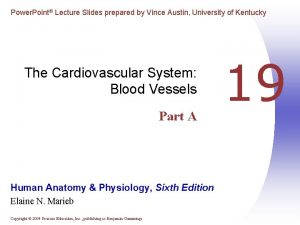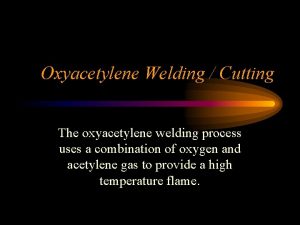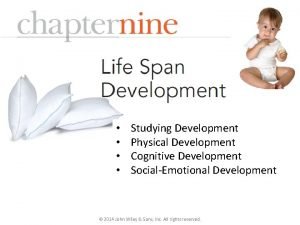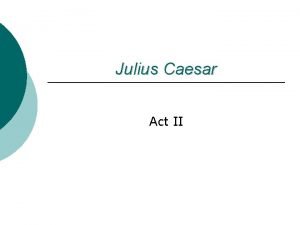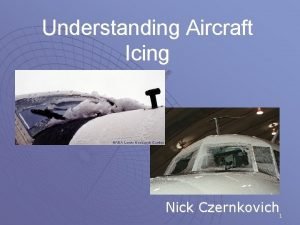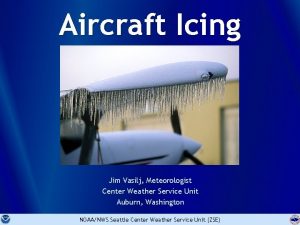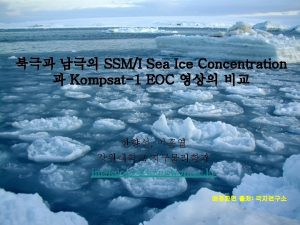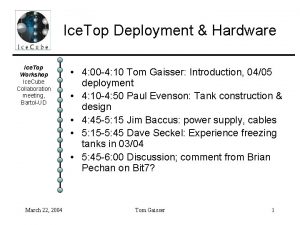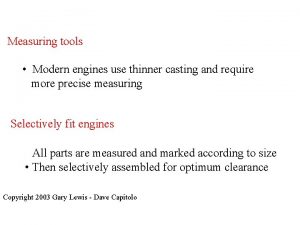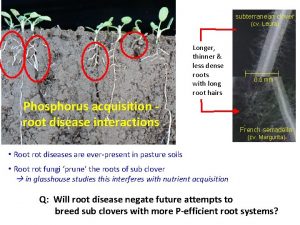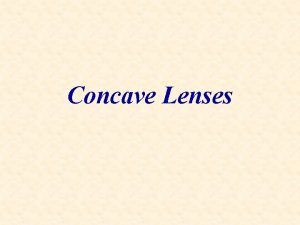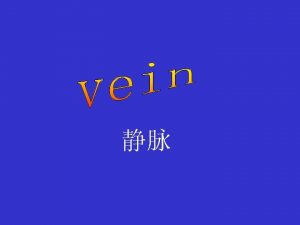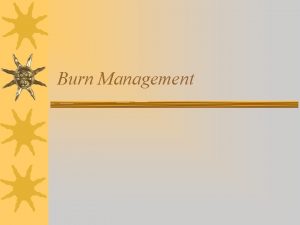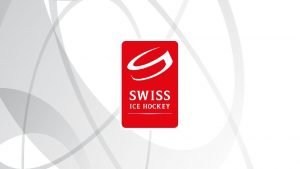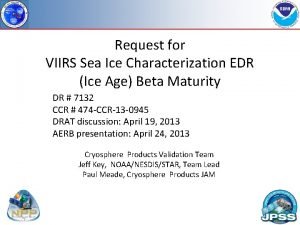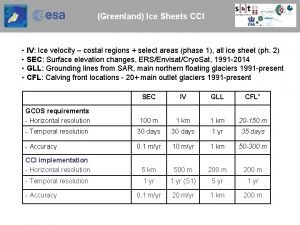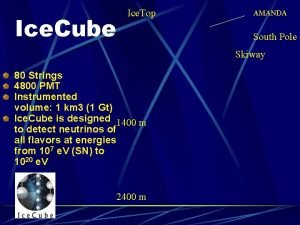The thinner the ice the more anxious is





































- Slides: 37

The thinner the ice, the more anxious is everyone to see whether it will bear. Billings HIGHER GRADIENTS IN MULTI-MODED ACCELERATING STRUCTURES? # S. V. Kuzikov 1, 2, S. Yu. Kazakov 1, 3, J. L. Hirshfield 1, 5, M. E. Plotkin 2, A. A. Vikharev 2, V. P. Yakovlev 1, 4 1 Omega-P, Inc. , New Haven, CT, USA 2 Institute of Applied Physics, Nizhny Novgorod, Russia 3 KEK, Tsukuba, Japan 4 Fermi National Accelerator Laboratory, Batavia, IL, USA 5 Yale University, New Haven, CT, USA # Work sponsored by in part by US Department of Energy, Office of High Energy Physics (2009).

OUTLINE OF TALK 1. The main idea is to attempt to raise RF breakdown thresholds by reducing the exposure time of surfaces to high fields, by use of multi-mode cavity excitation. 2. General scheme of the experiments is to build test cavities to be driven by a highcurrent bunched beam, with cavity mode frequencies that are harmonic multiples. 3. Why should this experiment be interesting for CLIC? 4. Why do we need CTF-3? 5. Two cavity geometries can be used to test this idea: 1. Rectangular cross-section cavities; and/or 2. Axisymmetric cavities. 6. Results of preliminary calculations using CTF-3 parameters: 1. RF E-field analysis in 1 -, 2 -, and 3 -mode cavities; 2. RF magnetic field analysis and pulse heating estimates; and 3. Preliminary analysis of multipactor threat. 7. A second related idea is to attempt to raise RF breakdown thresholds by using a two-mode, two-frequency axisymmetric, but longitudinally asymmetric cavity. 8. Methodology and possible time-schedule for the proposed experiments. 9. Accelerating structures and other ideas. 10. Summary.

Principle of acceleration in a multi-frequency structure A Acceleration of moving periodical sequence of bunches in independent cavities, operated by superposition of synchronized modes A E-field in A-A cross-section 1 – ideal (desired) time-dependence of the field, 2 – time-dependence of the field in an ordinary single-frequency structure, 3 – time-dependence of the field in a multi-frequency structure (with finite number of modes)

This solution is periodical in time (period equals period of the lowest mode), therefore, spectrum of the eigen modes of each cavity has to be equidistant one. lb bunches (v c) where n=0, 1, 2, … Here 0/ =p/q, where p and q are arbitrary integers. If taking finite number of modes, single peak duration is defined by the time, during which mutual phase of the lowest-frequency and highest-frequency modes reaches :

Raise of breakdown threshold due to reduction of exposure time A breakdown can be separated at several stages: At the primary stage RF electric field produces electrons to tunnel from microjuts, this effect is described by the Fowler. Nordheim law. At the second stage the microjuts are melted and evaporated. The freed molecules are ionized by oscillating electrons. The resulting plasma frequency grows up and approaches the field frequency. In [W. Wuensch et al, 2008] it is suggested to consider the first stage only, in order to find criteria of the breakdown ignition. According to that necessary condition to start a breakdown is a heating of surface by emission currents up to definite threshold temperature Tthr. The temperature rise T as a function of time t (with heat diffusion into metal taken into account): j – is a tunnel emission current, E- is a normal to surface field component, A – is a constant

where the expression behind integral is assumed to be different from zero if only E(t)>0, B and – are constants. or HG Workshop, W. Wuensh, 2008 E(t) and I(t) dependencies for single(1) and multi-frequency (2) structures

Note that positive field maxima are essentially bigger than absolute values of the negative maxima. This brings additional time-factor 2! Field dependence on time for single 3 GHz cavity, for 15 Field dependence on time for single 3 GHz cavity and GHz cavity, and for 3+9+15 GHz multi-mode cavity. for 3+6+9 GHz multi-mode cavity. In this case we expect raise of breakdown threshold due to reduction of exposure time ~51/6=1. 3. In this case we expect similar raise of breakdown threshold due to reduction of exposure time ~(2*(9 -3)/3)1/6=1. 26. However, there are not experimental proofs of such breakdown theory validity in case of a complicated microstructure of RF radiation.

In the paper A new local field quantity describing the high gradient limit of accelerating structures by A. Grudiev, S. Calatroni, and W. Wuensch it is proposed to use a new criteria of field limit due to RF breakdown in a form of the modified Poynting vector which naturally includes also a magnetic field magnitude: In particular, for majority of the accelerating structures Sc<5 W/ m 2 on structure surface at BDR<10 -6 and 200 ns pulse length. - is a complex value. How to apply these results in multi-mode case? In a three-mode cavity, if all modes have equal amplitudes, we have: If we fix maximum of electric field at e-beam to be the same for the single mode case and for the three-mode case: because all cross-terms under averaging give zero. gc =0. 15 -0. 20 in wide range of E-fields and very close to single mode case. Conclusion: breakdown threshold seems to be N times higher in multi-mode case, where N is a number of modes.

Possible experiments at CERN We suggest to build three cavities to be excited identically (by means of the same e-beam). We would like to compare probabilities of breakdown in these three cases: 1 -, 2 -, and 3 -mode cavities. The experiment conditions should provide the same Efield level in each cavity, in order to deal with effect of the different exposure time only. It is expected that 3 -mode cavity will be most breakdown proof among all others. Why should such experiment be interesting for CLIC? The experiment is aimed to investigate fundamental basis of the modern RF breakdown theory: • We plan to investigate dependencies of the breakdown threshold on the shape of RF microoscillations. People already investigated dependencies on the field magnitude and pulse duration as well. The only light spot is a dependence on shape of RF filling! • If a raise of the threshold will be shown, it opens a new way to accelerate particles with a higher gradient than usually.

Why do we need CTF 3? Our simple answer is that we are asking to use a unique facility of the CTF 3 for fundamental tests in accelerator R&D. To our knowledge, there is no other GHz-rate, high-current, high-quality beam in another lab to which we have access. The ANL drive beam consists of one bunch or, possibly in future, a maximum of 16 bunches. This is not enough to charge up our cavities. There is a proposal of Sergey Kazakov to use two KEK’s klystrons, in order to feed a two-frequency cavity. But this is absolutely another story… Probably the best place

List of CTF 3 parameters used in calculations: Electron energy, Me. V 120 50 - 120 Bunch charge, n. C 2. 33 1. 33 (4 A) Bunch diameter, mm 23 Bunch length, mm 2 Bunch frequency, GHz 3 Train length, s Repetition rate, Hz 10 0. 693 1. 3 - 5 1 Two geometries of test cavities were considered: Rectangular cross-section cavities Circular cross-section cavities

Rectangular cross-section cavities Such a cavity is the simplest example of a system having equidistant mode spectra. 3 -mode cavity mode frequency, GHz Q-factor TM 110 3. 00 6220 TM 330 9. 02 11090 TM 550 15. 00 14480 mode frequency, GHz Q-factor TM 110 3. 02 6110 TM 330 8. 98 10450 TM 550 14. 85 330 mode frequency, GHz Q-factor TM 110 3. 00 5450 TM 330 9. 64 570 TM 550 15. 13 80 2 -mode cavity Single mode cavity Unfortunately, properties of the cavity with beam hole are essentially different from properties of the unperturbed cavity.

Three-mode axisymmetric cavity with modes at 3 GHz, 6 GHz, and 9 GHz The first design problem is how to obtain equidistant mode spectrum. This problem is solvable by specific cavity shape (each mode frequency is tuned by its own sin-like wall profile harmonic). Beam channel E-fields of eigen modes

The Poynting vector value in three mode cavity in maximum is SC=0. 45 W/ m 2.

Design of 1 - and 2 -mode cavities One of main design problems is how to provide similar field level in all three cavities. There are two principal ways: 1. To keep the same beam current and to equalize surface fields in cavities by shapes (“noses” to increase local field ). 2. To keep similar cavity shape in all three cases and to compensate different field levels by changing of the current. n Recomme group IC RF L C f o n io dat

Single mode cavity at 3 GHz with field level like in 3 -mode cavity Beam channel “nose” E-field of the operating mode Magnetic field of the operating mode. Maximum of E-field at surface is close to the correspondent maximum in 3 -mode cavity.

Modified list of parameters: Electron energy, Me. V Bunch charge, n. C Bunch diameter, mm 50 - 120 1. 33 (4 A) 10 Bunch length, mm 5 Bunch frequency, GHz 3 Train length, s Repetition rate, Hz 1. 3 - 5 1 -10 Field level is less by factor 1. 75 in comparison with the previous calculations, but we are able to compensate this loss by increasing pulse duration from 0. 7 s up to 4 s.

Investigation of detuning effect in 3 -mode cavity The necessary condition to keep good excitation level is f<f/Q, where f 2=6 GHz, Q 2=8500, f 3=9 GHz, Q 3= 11000. The third mode detuning is less influent in comparison with the second mode detuning.

Diagnostics of breakdown Cavity Rogovsky “belt” (coil) beam Hole for RF antenna Difference amplifier Idea of Jan Kovermann Design with side waveguides (cut off frequency is slightly more than 9 GHz) provides: 1. Autofiltration of spurious modes, 2. Visual control by means of arc detector and fast camera (through quartz windows) Additional tools could also be: 1. Lenses instead of windows to use several cameras at once in order to provide tomography image processing 2. Measurement of high field harmonics which are usually produced by RF breakdown

There’s a better way to do it. Find it! Thomas Edison Raise of breakdown threshold in asymmetric cavity a) U Anode Cathode b) U Cathode Anode The DC voltage is the same in both cases, nevertheless in case (a) breakdown threshold is bigger than in case (b)! Instant field At RF field electron emission is impossible, if E-field pushes electrons in a wall. In a single mode cavity this fact means nothing, because RF field oscillates exactly between +maximum and –maximum. “Cathode” and “Anode” replace each other for a half of period. In a multi-mode cavity situation is quite different!

Multi-harmonic cavity without longitudinal mirror-symmetry allows to have not equal “anode” and “cathode” fields at metal surface, to have “anode” field much higher then “cathode”. We can suppose that breakdown is determined only by cathode (we know that anode can sustain higher electric field then cathode). This kind of cavity has higher ratio of acc. gradient to surface breakdown field and provides higher acc. gradient. In the RF cavity “anode” and “cathode” change places with frequency F.

Let us consider a cavity having two axisymmetric modes at frequencies f and 2 f respectively: “Anode” Ez Right wall Left wall E 0 “Cathode” 0 E 1 L Longitudinal field distribution of the first asymmetric mode at frequency f Field on the left wall The field on the left wall has maximum about +2 E 0. But +2 E 0 is actually “anode” field. “Cathod” field on the left wall is -E 0. The field on the right wall has maximum E 1+E 2 <E 0 (assumed to be less than breakdown threshold) due to assymetry. Ez E 0 E 2 0 L Longitudinal field distribution of the second asymmetric mode at frequency 2 f

Optimal combination (amplitudes): AF = 1, A 2 F = 0. 65 a 2 = G / E_cth = 1. 251 Improving: a 2 / af = 1. 251 / 0. 935 = 1. 338

Excitation of asymmetry cavity by CTF 3 electron beam 15 mm hole Conclusion is that amplitudes of the excited eigen modes are close to optimum.

Future accelerating structure: Conclusion: Adding relatively small fraction (amplitude 0. 35 -0. 5) of second harmonic we can increase accelerating gradient about 35 % ! And, of course, to reduce length of a collider. And, probably, to save several billions of $…

Possible experiments in CLIC: 1) Checking difference between “anode” and “cathode” 2) Comparing longitudinal symmetrical and non-symmetrical cavities

Great intellects are skeptical. Nietzsche What results do we expect to obtain in the end? 1. Optimistic case We prove that reduction of exposure time allows increasing breakdown threshold. This proof opens a green light for all calculations based on the present breakdown theory. A raise of threshold would allow to invent new structures with higher gradient. 2. Pessimistic case We do not see difference between cavities (taking into account the accuracy of the experiment). This requires to reconsider the breakdown theory! 3. The worst case We can not state neither (1) nor (2). Such result could be because influence of so-called not taken into account factors: 1. Pulse heating 2. Multipactoring

Pulse heating effect in the 3 -mode cavity Magnetic fields of the 1 st, 2 nd, and 3 rd modes. Temperature rise in three-mode cavity is ~60 degrees C. In two-mode cavity T~ 50 degrees C. This temperature level allow working at least up to ~106 pulses [Tantawi et al, 2008].

Preliminary multipactor analysis - equation of electron motion by Lorentz force Electron motion can be respresented as a sum of fast oscillations and slow drift: The second term describes slow average motion (drift) of an electron in electric and magnetic RF fields where - Miller force Potentially dangerous places in viewpoint of multipactor are where electric field magnitude and Miller force go to zero simultaneously. These places correspond to stable equilibriums (red spots). F=- - - Field distributions of 3, 6, and 9 GHz modes and corresponding Miller force Green spots are unstable equilibriums.

F=- Secondary emission coefficient Full Milller force of 3, 6, and 9 GHz modes H Hr Beam channel Trajectories of primary and secondary electrons Ez Secondary electrons are able to be born at side wall. Initial energy 3 -5 e. V. All trajectories of electrons due to the resulting Miller force go to the side wall. Assume that these electrons cause secondary electrons. Do secondary electrons produce next generation of particles? So, let us investigate multipactor threat at side wall.

Full electric field of 3, 6, and 9 GHz modes in the center of cavity Side wall Full magnetic field at side wall Trajectories of electrons started at side wall

Energy of incoming to side wall electrons Maximum energy of incoming electrons at as a function of field phase under E=370 MV/m side wall In dependence on full electric field for single mode TM 010 cavity and for three in the center of cavity (3 modes) mode cavity TM 010, TM 020, TM 030. At 370 MV/m there are electrons which gather about 100 e. V energy before to drop on side wall. Such electrons are able to born secondary electrons with reproduction more than 1!

H 0 Ez y Energies of secondary electrons incoming to side wall and trajectories of most energetic electrons E=370 MV/m Full magnetic field of 3, 6, and 9 GHz modes at side wall and trajectories of secondary electrons E=370 MV/m Most dangerous high energetic electrons (with W 100 e. V) finish its paths at similar field phase (when magnetic field reaches maximum). The secondary electrons born in this phase can not gather enough high energies in order to provide growth of electron concentration.

Preparation and time schedule In order to start experiment (in case of your approval) we will have: 1. To finish necessary calculations (results to be confirmed by you). 2. To calculate beam optics (quadrupole doublets). 3. To elaborate methods of breakdown diagnostics. 4. To coordinate pumping and flanges. 5. To produce and to test cavities, to produce doublets and diagnostic equipment. 6. And to solve all administrative problems (money, manpower etc)… So, if all these steps will be done, the experiment start could be not earlier than the end of 2010.

Two-beam two-sections multi-mode accelerating structure with aspect ratio 1: 2 Drive-beam – electrons Accelerated beam - positrons


Summary 1. The proposed multi-mode experiment to raise RF breakdown threshold is able to help in understanding of fundamental nature of this phenomena. 2. CTF 3 seems to be the most comfortable and powerful tool. Beam optics of CTF 3 can be adopted for purposes of experiment. 3. Two kinds of experiments are considered: - with axisymmetric cavities having modes with symmetric distribution (the expecting threshold raise is ~1. 3), - with axisymmetric but longitudinally asymmetric modes (the expecting threshold raise is about 2). 4. Preliminary analysis shows that pulse heating and multipactor phenomena do not spoil experiment aims. 5. Methodology implies comparison of breakdown probability in 1 -, 2, and 3 -mode cavities under the same E-field level and visual observation of breakdown insight cavities. 6. Start of experiment could be in the end of 2010 - beginning of 2011.
 More more more i want more more more more we praise you
More more more i want more more more more we praise you Lirik lagu more more more we praise you
Lirik lagu more more more we praise you Vince have thinner walls than arteries
Vince have thinner walls than arteries The regulator diaphragm is often made from
The regulator diaphragm is often made from A wrangler and buffoon
A wrangler and buffoon Anxious arousal meaning
Anxious arousal meaning Anxious attachment quotes
Anxious attachment quotes Apprehensive vs anxious
Apprehensive vs anxious Cross sectional and longitudinal research difference
Cross sectional and longitudinal research difference The necklace anticipation guide
The necklace anticipation guide Apprehension vs anxiety
Apprehension vs anxiety Ashamed gerund or infinitive
Ashamed gerund or infinitive Psalms 94 17
Psalms 94 17 What promise does brutus make to rome
What promise does brutus make to rome Anxious gerund or infinitive
Anxious gerund or infinitive Nick czernkovich
Nick czernkovich Clear ice vs rime ice
Clear ice vs rime ice Newtons first law example
Newtons first law example Human history becomes more and more a race
Human history becomes more and more a race 5 apples in a basket riddle
5 apples in a basket riddle Knowing more remembering more
Knowing more remembering more The more you study the more you learn
The more you study the more you learn More love to thee o lord
More love to thee o lord Aspire not to
Aspire not to More choices more chances
More choices more chances Bổ thể
Bổ thể Chụp phim tư thế worms-breton
Chụp phim tư thế worms-breton Tư thế ngồi viết
Tư thế ngồi viết ưu thế lai là gì
ưu thế lai là gì Thẻ vin
Thẻ vin Thơ thất ngôn tứ tuyệt đường luật
Thơ thất ngôn tứ tuyệt đường luật Các châu lục và đại dương trên thế giới
Các châu lục và đại dương trên thế giới Từ ngữ thể hiện lòng nhân hậu
Từ ngữ thể hiện lòng nhân hậu Diễn thế sinh thái là
Diễn thế sinh thái là V cc
V cc Làm thế nào để 102-1=99
Làm thế nào để 102-1=99 Tỉ lệ cơ thể trẻ em
Tỉ lệ cơ thể trẻ em Chúa yêu trần thế
Chúa yêu trần thế


